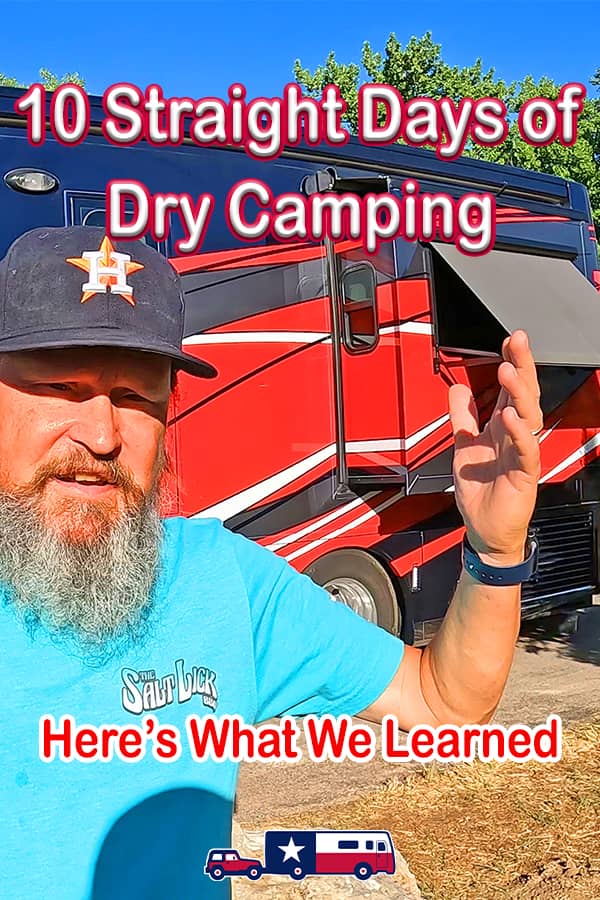Here's What Happened During Our 10 Day Dry Camping Adventure
In this video, we take you along for a day-by-day account of our recent 10-day boondocking adventure. How did it go? What happened? How did our 48-volt lithium and solar system work out? Were we able to run our air conditioners off of our RV's batteries? How did we get fresh water? Where did we find dump stations? Did we run the generator? What did we learn from this and previous dry camping experiences with our RVs? We share all of that and more in this week's video.
Watch This Episode:
Video: We Dry Camped for 10 Straight Days, Here's What Happened
This video was filmed in July and August during our 10-day RV camping visit to Flaming Gorge National Recreation Area and Dinosaur National Monument in Northeast Utah, USA.
What is Dry Camping?
Dry camping, also known as boondocking, is camping without hookups... No electrical hookups, no water connection and no sewer connection.
When dry camping, you are completely reliant on your RV's house batteries, fresh, grey and black water tanks, and propane tank (if equipped).
In 2021, we outfitted our Newmar New Aire with 2,280 watts of solar panels and a 48-volt electrical system including a 5,000VA inverter and 600 amp hours of lithium batteries at 48-volt (equivalent to 2,400 amp hours at 12-volt). We documented the building of our system. You can see it in our RV Solar and Lithium: Our Extreme 48-Volt System post.
And yes, we also have an on-board generator.
This extended dry camping trip during the summer was a great test for our system and really helped us learn a lot about it.
Do You Need a Massive Solar and Lithium Battery System to Dry Camp?
No, absolutely not. Back in 2019, we dry camped for 28 out of 30 days in our Tiffin Breeze. That motorhome had 320 watts of solar on the roof, 4 standard lead acid batteries and an on-board generator.
Prior to that, we boondocked in our Thor Palazzo motorhome which had an on-board generator and standard lead acid batteries. We did not have any solar panels on that RV.
No matter what type of RV you have, you need to have some way to charge your house battery(ies).
What Have We Learned and Tips for Dry Camping
We share several big boondocking tips throughout today's video. But here are a few others that we forgot to mention...
Never assume that the campground where you plan to dry camp has a water fill station that you can connect your RV's water hose to. Both of these campgrounds had potable (safe drinking) water available. But neither had a water spigot that we could connect a hose to. If we aren't 100% confident that we will be able to fill our fresh water tank onsite, we always arrive with a full tank of fresh water.
If you don't want to drive a long distance with a full fresh water tank, do some research to look for a clean dump station with potable water or an RV park that will allow you to fill your tank along your route, closer to your destination. As we mentioned in the video, if you have any doubts, it's a good idea to look at the dump station on google maps satellite view and/or read reviews to make sure you can fit and manuever without a problem.
Putting your RV's slides out and bringing them in, and extending/retracting leveling jacks can use a decent amount of battery power. So we operate the slides and the jacks while our engine is running.
Our Magne Shades go a long way to keeping heat out of our windshield and cockpit windows. The shades are made by a family-owned business in North Carolina. We have a video about our Magne Shade install on our YouTube Channel. You can order them for any windows that let in a lot of heat.
If you have never dry camped in your RV, consider doing a few test runs at a campground where you have hookups. While we do not suggest running your generator in a park like this, you can definitely disconnect from the electrical box and city water to get a feel for the capacities of your batteries and water tanks. Then just reconnect when you are ready to recharge.
We always carry an extra water pump. You might be able to run for many years without any issues with your water pump. But when they go out, it's always unexpected. Luckily, water pumps are usually easy to replace. So we carry a spare, just in case.
Our current motorhome is all electric. But if your RV uses propane, you can do a lot to minimize your use of power by using your propane water heater, cooktop and furnace if necessary. We have never used our electric water heaters when dry camping... they use a lot of power. These days, we use our Oasis burner to heat our water and only leave it on when we need it.
And that is a huge key... while dry camping, we only use things when we need them.
LED lights go a long way toward saving energy when it comes to lighting. If your RV isn't equipped with LED lightbulbs, they are usually easy to change.
We mentioned how much our window awnings and main awnings help to block heat from the RV and provide shade. But it's important to note that we NEVER leave our awnings out when we are not outside at the RV. You never know when that unexpected gust of wind will swoop in, and we've seen way too many damaged and torn awnings on RVs over the years.
We've been wanting to write a post with tips for keeping the RV cooler. We'll try to work on that soon!

